The story of Charlie Fawn is an intriguing one. You might say a tale of ‘what might have been’ but for the twists and turns of fate. A friend and former manager has said that he has never understood why Charlie wasn’t either very famous or very rich. A puzzle, a conundrum. But a lifetime of creativity without critical or public acclaim is not the whole picture. Yes, there must be as many more artists who have remained unheard of or uncelebrated than those who have enjoyed all the trappings of success; but the creative offerings and output must finally speak for themselves. With the advent of the Internet it became clear that there were folk in different parts of the world who had loved and still do enjoy Charlie’s music: those who were teenagers when he first performed and bought his early singles and LP, and those who have since collected vinyl from that era and have posted on the Web how much they liked his material, and wished to hear more of it: one called his eponymous album a “lost classic”, another that every song was a “hit”, another “that LP is a killer!”. So, here is that story.

Charlie Fawn was a ‘face’ on the London punk and New wave scene of the late 1970’s, best known for his WEA singles “Blue Skies” and “Hothead Handshake Tremble”, whose friends and acquaintances included Soo Catwoman, Captain Sensible, Steve Strange, Shane MacGowan and (best friend) Larry Hinrichs of the Nips, Ian Page (Paine) of the New Hearts and later Secret Affair, Del- the Pistol’s roadie, Kris Needs of ‘Zigzag’ magazine, B.P.Fallon, Danny Baker of ‘Sniffin’ Glue’ fanzine, Bobo Phoenix and Jeff Parsons of Dead Fingers Talk, Kosmo Vinyl (Clash and Blockheads road crew), Kenny Morris – drummer with Siouxsie and the Banshees, B.P – drummer with X-ray Spex and Classix Nouveaux, Dave Burke- drummer with Johnny Moped, Phil Spalding (bass) and drummer Mark Harrison from Bernie Torme, Jimmy Pursey of Sham 69, J.J.Johnson of Wayne (Jayne) County and the Electric Chairs, Billy Currie of Ultravox, Chrissie Hynde and James Honeyman Scott of the Pretenders ( who he used to chat to over coffee in the WEA Press offices in 1979) plus a host of others who all rubbed shoulders with the famous names and faces of the time. He also met Andy Smith, guitarist of the Mirrors from Wales (“Cure for cancer” on Lightning Records) who later joined him in the band Battersea.
It might be true to say with hindsight, that his unique musical talent bridged a gap between Bowie, punk, New Wave, the ska of Madness and the Specials and the New Romantics….though this was not appreciated at the time.
On October 11th 2016 ‘Bubble-gum punk’ singer Helen Love from Swansea wrote in the Velvet Sheep Magazine Archive about Charlie’s song ‘Blue Skies’: “Charlie could’ve, should’ve been a massive teen idol. All his songs are great….but the world wasn’t ready. He looked great, and could pull all the shapes, and he should have been the King of the inner city estates…!”
But to go back to the beginning…….
An illegitimate baby boy, whose mother Eve Morris named him Neville was born in Birmingham, U.K on 6th December 1957. As the daughter of an Anglican clergyman in north Wales it was deemed unsuitable for her to keep the child and he was put up for adoption. He grew up in Shropshire from 1958 as Charles Ridgway Coxill and straight away amongst his earliest memories were the music and stars of the pop music world in those days…Adam Faith, Billy Fury, Helen Shapiro (‘Walkin’ back to happiness’, who he also had the pleasure to meet)…the Beatles, the Rolling Stones ( ‘Little Red Rooster’ being a 6th birthday present)…Gerry and the Pacemakers, the Searchers, the Dave Clark Five, the Hollies, Manfred Mann ( whose Tom McGuinness would produce Charlie’s records years later, and singer Paul Jones who dropped in on his recording sessions) Cilla, Dusty Springfield, Sandie Shaw (who would be an inspiration ) and Dave Dee (who signed Charlie to WEA in 1979!) of ‘Dave Dee, Dozy, Beaky, Mick and Titch’….he would never have dreamed as a child watching the New Musical Express Awards shows on T.V, or Ready Steady Go and Top of the Pops that he’d meet and even work with some of them one day!
He showed an early gift and natural talent for singing, joining his father in the local church choir, which resulted in a chorister-ship in 1967 to King’s College Choir Cambridge. There he sang for 5 years in the world famous choir under Sir David Willcocks, inhabiting a world of worship and classical music, where he crossed paths with Benjamin Britten, Sir Peter Pears, Yehudi Menuhin and other luminaries, even performing once with the choir at a private Christmas concert for the whole Royal Family at Windsor Castle.
But…..his ear for ‘pop’ was strong as ever throughout this period, and he taught himself to play and sing “Lola” by Ray Davies and the Kinks. It was the beginning….!

At 13 he moved on to the King’s School Canterbury, where he was known for his musical talent and theatrical flair, performing an evening of Glenn Miller songs backed by Orchestra,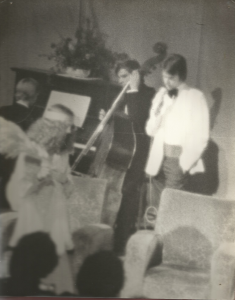 and singing at many school concerts and in the Cathedral. Even so, many more fellow pupils will remember him for performing “Life on Mars”and “Ziggy Stardust” by David Bowie, “All the young dudes” by Mott the Hoople (who he’d also meet later!) and “Satellite of Love” by Lou Reed at the piano, before the arrival of the teachers and Headmaster at School Morning Assembly! Canon Newell, the headmaster, often called for him after assembly to commend him for this or that concert, but also to enquire with a shake of the head whether that ‘was blue eye-shadow and an ear-ring he was wearing?!’
and singing at many school concerts and in the Cathedral. Even so, many more fellow pupils will remember him for performing “Life on Mars”and “Ziggy Stardust” by David Bowie, “All the young dudes” by Mott the Hoople (who he’d also meet later!) and “Satellite of Love” by Lou Reed at the piano, before the arrival of the teachers and Headmaster at School Morning Assembly! Canon Newell, the headmaster, often called for him after assembly to commend him for this or that concert, but also to enquire with a shake of the head whether that ‘was blue eye-shadow and an ear-ring he was wearing?!’ Charlie chopped his own hair style into spikes at the time, like his friend Bing Lyle ( of folk-band the Sussex Pistols), years ahead of punk….’My school-days insane, my work’s down the drain!’ During those days at school he listened to a wide musical range, from Led Zeppelin, Dylan and Leonard Cohen, to Pink Floyd, Can and Faust. He also got into 50’s rock n’roll, such as Buddy Holly, Eddie Cochrane and Gene Vincent. A friend often played “When I’m dead and gone” by McGuiness Flint. How could he have known or believed that in a few years he would be working with Tom McGuiness and have met Hughie Flint?
Charlie chopped his own hair style into spikes at the time, like his friend Bing Lyle ( of folk-band the Sussex Pistols), years ahead of punk….’My school-days insane, my work’s down the drain!’ During those days at school he listened to a wide musical range, from Led Zeppelin, Dylan and Leonard Cohen, to Pink Floyd, Can and Faust. He also got into 50’s rock n’roll, such as Buddy Holly, Eddie Cochrane and Gene Vincent. A friend often played “When I’m dead and gone” by McGuiness Flint. How could he have known or believed that in a few years he would be working with Tom McGuiness and have met Hughie Flint?
Flashman Fawn 1975! 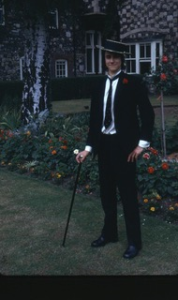
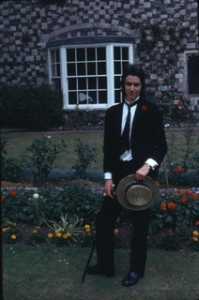
It was 1974-5 and he had begun writing songs by now, strongly influenced by Bowie, Lou Reed and the Velvet Underground, and was listening to Roxy Music and Brian Eno ( with Fripp). He recorded early songs such as “Facade”, “Sweetheart”, “Focus” and “Rock n’roll Mystery”, with his best school-friend Alex Sampson operating the cassette machine. Alex wanted to manage him, seeing the latent potential for stardom. It was in these years that he began a life-long interest in the ‘spiritual’ life, fascinated by the balance or perhaps conflict between ‘fame’ and ‘enlightenment’ as epitomised in George Harrison; he found it most interesting that David Bowie had considered becoming a Zen monk.
Fate took its next twist…just like in a film!
He boarded a train for London, one half term holiday in 1975 at Canterbury West station, with his friend Paul Murphy. He had “Down by the Jetty” by Dr. Feelgood under his arm at the time. He had noticed a guy on the platform, greased hair and leather jacket who had a ‘flight’ brief case with stickers on it…”SHA NA NA – greased and ready to kick ass!”…. the thing being he had recently been listening to their LP ‘Live-From the streets of New York'(!) This guy then sat in the same small compartment.
Charlie’s friend Paul, during conversation, asked him if he was going to write any songs that weekend? And after he replied he might, the guy took off his ‘shades’, turned to Charlie and enquired what sort of songs he wrote? He then introduced himself as Mal Gray, himself in the music business, and he said he’d like to hear some of his material. They exchanged contact details and talked a bit about Mal’s career. He had been lead singer of the Wild Angels, a well-known rock n’ roll revival band, who had had some success, and he’d also guested with SHA NA NA in the States! They agreed to meet up sometime soon.
Within the year Mal Gray and his drummer Steve Murray had listened to and been very impressed by Charlie’s early song-writing attempts (particularly with “Rock n’ roll Mystery”, which was never properly recorded in the end, and also “Sweetheart”). So Mal arrived at the Mint Yard gates of the school that summer in a huge Silver Oldsmobile to suggest whether Charlie would like him to maybe manage him and help him out? Despite the plan being a return to choral life in Cambridge, probably much to his parent’s chagrin he had other plans…to be a Rock star. The answer was “Yes!”
His ‘swansong’ quite literally, at the King’s School Canterbury was to sing the lead solo in a performance of the Negro-spiritual “Were you there?” for a Spring edition of the BBC programme ‘Songs of Praise’, featuring Kent schools. Recorded in December, a few days before Charlie’s 18th birthday, it was aired in early 1976, and is almost certainly lost or wiped. He collapsed on his birthday with apparent appendicitis and quietly left the school unnoticed. He recuperated at his girlfriend Felicity’s house in Canterbury, before heading back to Shropshire to plan world domination.
Sometime that year he went to see Dr. Feelgood at Hammersmith Odeon with Felicity. He couldn’t wait to be up there too. He began to think he should have a stage name, like Bowie or Bolan. He’d been fascinated by a TV dramatisation of Howard Spring’s book “Shabby Tiger”, in which there was a bohemian artist named Nick Faunt. Being daft and listening to everything from Jobriath to The Pasadena Roof Orchestra he landed on ‘Charleston Faunt’, but as it sounded undoubtedly fey and somewhat ridiculous he honed it to ‘Charlie Fawn’, rather like Goldie Hawn: that’s how he described it when asked……..The ‘persona’ was born.
Being daft and listening to everything from Jobriath to The Pasadena Roof Orchestra he landed on ‘Charleston Faunt’, but as it sounded undoubtedly fey and somewhat ridiculous he honed it to ‘Charlie Fawn’, rather like Goldie Hawn: that’s how he described it when asked……..The ‘persona’ was born.
In early 1976 “Charlie Fawn” journeyed again from the Midlands down to London, and was met by Mal at Euston in that impressive car. Before heading down to lodge with Mal in Bromley, he suggested he might like to head into town. So, presently Charlie found himself entering Air Studios, where Mal introduced him to the guys from Mott the Hoople, who he knew(!), and chatted with bassist Pete Overend Watts and drummer Buffin. They were there recording a new album after the departure of Ian Hunter as Mott, which would be released as the follow-up to ‘Drive On’. Also hanging around were some of the band Roxy Music, such as saxist Andy Mackay, and members of Mr.Big…whose singer Dicken thought Charlie was a girl!
Coincidentally, Charlie would later meet Pete Overend Watts again and visit his house with punk friend Soo Catwoman, who also knew Mott’s piano-player Morgan Fisher, who knew Hazel Northcott ( Mal’s partner at the time, who worked for John Sherry and Miles Copeland of ‘Sherry Copeland Artists’. By 1978 she ran the Vortex Club in Wardour Street !)
Charlie lived with Mal, Hazel and their dog Rebel in Bromley, the first plan being for him to play piano in Mal’s new band. Whilst out and about he saw a copy of the paper ‘Anarchy in the UK’ with the famous shot of Soo Catwoman on the cover. He would soon see Siouxsie Sioux and Steve Havoc ( Severin) on the train into Victoria. Punk had begun. He was fascinated.
Mal’s friends John Dove and Molly White (clothes designers of ‘Wonder Workshop’ who had dressed Mick Jagger, Marc Bolan and Malcolm McDowell among others, their Leopard T-shirt ‘Wild Thing’ being best known and the leather jacket made for Iggy Pop …John was a huge Troggs fan) came visiting. Charlie was intrigued by John, who wore gold Wellington boots and a self-designed jacket covered in big red lips, and Molly’s bleached spiky hair. They were full of talk of a band called the Runaways from the States, who Charlie met at the Vortex the next year (chatting with Joan Jett) and shared in common Tour Manager Tony Gibbings, who had minded Steve Harley of Cockney Rebel (another band Charlie listened to at school!) When Charlie went to their workshop he was amazed at John’s big pink Cadillac parked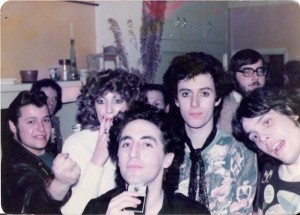 outside, his collection of Jukeboxes filled with Troggs and American trash music (pre-punk) records. He bought John’s Leopard-skin naked girls T-shirt…a prized possession and fashion item for a few years.
outside, his collection of Jukeboxes filled with Troggs and American trash music (pre-punk) records. He bought John’s Leopard-skin naked girls T-shirt…a prized possession and fashion item for a few years.
Charlie (left) wearing that famous T-shirt at a party in Hampstead in 1978. (In foreground is Philip Sallon, friend of Boy George and one of the Bromley Contingent of Sex Pistols fans. On Charlie’s left is Dave Stark).
The train trips to Victoria station would before long lead on to a huge leap in Charlie’s career. After a while Mal introduced him to the rest of the new Mal Gray Band, which he had put together after returning from the States. He felt a grounding in the business like this would be good for the young and inexperienced ex-public school boy. The other guys came from some of the best 50’s rock n’ roll bands on the London scene, including Jerry Tilley ( who Charlie worked with in the mid 80’s on solo material). They were joined by bass player Paul Karas from the band Stackridge, who looked like an Apache with his long hair, compared to the ‘greasers’ in the band; Charlie by now was sporting a Keith Richards ‘mop’ hairstyle. His favourite album of the moment was Patti Smith’s “Horses”.
Despite some initial suspicion of this young upstart the other seasoned rockers soon recognised Charlie’s talent. Rehearsals got under way for a prime gig at the New Victoria theatre, supporting legendary New Orleans star Fats Domino. At the gig Charlie squeezed into a tight silver spandex suit, cheap but big rings on his fingers, ‘brothel-creeper’ shoes on his feet. Felicity and some other old schoolfriends witnessed this first step to stardom. After an introduction by DJ Tommy Vance he played piano, rhythm guitar and even trumpet (on “Promised Land”), the only hitch during the show getting the rings caught in the guitar strings in front of 2,000 people and having to yank his hand out! Fine, except the acoustic guitar belonged to guest musician Pete Gage, ex-Vinegar Joe and old friend of Mal’s!
It took Charlie days to come down from the high of the gig; some recordings were made in a studio in Covent Garden, which do not survive, but included “Under the Spell” and “Don’ be Long” by Charlie and some co-written with Mal. They went into the studio in evening daylight and emerged after dawn into daylight…..this was rock n’ roll, he thought.
For recreation he went to ‘Ronnie Scott’s’ nightclub to see Joan Armatrading and the Movies play, whose album “Back to the night” Pete Gage had produced. There he got drunk with Pete’s wife singer Elkie Brooks, who he loved with her smoky whiskey voice and uninhibited behaviour. Sometime later they did some recording together, working on the song “Wonderful Soupstone” by Dr. Hook. Mal was on lead vocals, with Charlie and Elkie on backing vocals, Charlie on piano, Steve Yorke (from Vinegar Joe) on bass and Trevor Morais of Quantum Jump and The Peddlers on drums. Charlie put down some decent piano tracks on several takes, but at his first mistake the ‘older’ musicians present jumped in to say the track wasn’t working (Rock n’ roll!) and eventually nothing came of the sessions. (Elkie and Pete had also been in the band Vinegar Joe with Robert Palmer).
Another gig followed supporting legendary Bill Haley and his Comets, again at the New Vic. It was a riot, as the London Teddy Boys went berserk, even making the headlines of the next day’s ‘Evening Standard’ newspaper. Haley didn’t seem to notice the bottles whizzing past his head, unlike his terrified jazz-drummer Wayne, who hid behind his kit! The gig was stopped several times, as London Ted ‘Sunglasses Ron’ attempted to calm the crowd…..this was rock n’roll, Charlie thought.
During that year he moved and lodged with guitarist Jerry Tilley and family in Clapham, and also had a session playing keyboards with the heavy rock band UFO: it was another means to broaden Charlie’s experience. He met and got on well with Phil Mogg (singer) and then jammed on UFO songs with guitarist Michael Schenker and bassist Pete Way. Marc Bolan’s ex-wife June Child and Paul Varley, drummer of The Arrows, popped in with beers. Yet again Charlie was fired-up with the whole rock n’ roll life-ethos, but the band though well impressed with his playing decided he was too young to keep up with their life of excess on the road, so end of story.
It wouldn’t be long before punks were appearing on the streets, the Sex Pistols swearing on the Bill Grundy Show, and a new era dawning. At the time the Mal Gray Band embarked on European tours with both Bill Haley and then Fats Domino…………..
There was another riotous gig in Berlin with the Comets, at the Cheetah Club, with flying missiles amongst the transvestites and rockers, a chance to gaze across the Berlin Wall and see Checkpoint Charlie. A high point in the gig for Charlie was playing an energetic rendering of “Break up” by Jerry Lee Lewis, probably his first experience of leading as a ‘frontman’ on stage. Berlin seemed to live as if tomorrow was the end of the world. On this tour new bass-player was Jimmy Wiley, who had worked with Roxy Music, and Gordon Scott who later joined Matchbox.
On the Domino tour in early 1977 the highlights for Charlie were sitting by invitation with Fats at his dressing room piano playing a duet, watching those big diamond rings flashing….and having breakfast of ham and eggs with bandleader and Domino’s songwriting partner Dave Bartholomew. He also got to know guitarist Roy Montrell, whose wry humour and charisma resulted in Charlie partly writing his song “Shot, loud and naughty” about him. Lee Allen, who had played Sax on Little Richard’s records and the great showman Shane Kimble were part of Fats Domino’s band at the time.
After a March Gig in Germany the band were hanging around their hotel foyer, guitar cases and baggage all around, when Charlie noticed there seemed to be a number of fans outside the front of the hotel, sporting David Bowie ‘Low’-style red haircuts. Puzzled, he wondered why? The answer walked through the door…..Lou Reed! Charlie had been a fan himself for years ( the ‘Transformer’ album produced by Bowie and Ronson an all time favourite, never mind the Velvets) and soon found himself having a good conversation with Lou about the venue, last night’s gig and so forth! Lou was playing the same theatre that night. Only a true music fan, who had himself gone into a musical career would know how it felt to be alongside a teenage hero, and be treated as an equal.
David Bowie ‘Low’-style red haircuts. Puzzled, he wondered why? The answer walked through the door…..Lou Reed! Charlie had been a fan himself for years ( the ‘Transformer’ album produced by Bowie and Ronson an all time favourite, never mind the Velvets) and soon found himself having a good conversation with Lou about the venue, last night’s gig and so forth! Lou was playing the same theatre that night. Only a true music fan, who had himself gone into a musical career would know how it felt to be alongside a teenage hero, and be treated as an equal.

During these European tours it had also been a pleasure to have in the band and work with 2 musicians from the States: Chico Ryan from SHA NA NA and John Paiva from the Four Seasons. Charlie had loved that ‘Streets of New York’ album, and had great times with Chico on the road – many will have glimpsed him clad in golden lame suit in the film ‘Grease’ during the high-school dance contest, in the showband! And John had enjoyed great success with both Franki Valli and the Four Seasons in the few years previously, with hits like ‘December ’63 (Oh what a night!)’ and ‘Silver Star.’
And John had enjoyed great success with both Franki Valli and the Four Seasons in the few years previously, with hits like ‘December ’63 (Oh what a night!)’ and ‘Silver Star.’
Upon return to the UK, Charlie chopped off all his hair again, covered his shirt in safety-pins and flung himself into the burgeoning London Punk scene. He got a bedsit in Clapham, SW4, a few doors along from Charlie Harper and the UK Subs. He met up with old school friend Mike Selleck who lived in the same house and hung out with some of the interesting characters from squats off Queenstown Road. Punk music blared from his bedsit all hours as he devoured all that was being released and he went to countless gigs at the London clubs, the Roxy, the Vortex etc. At the latter Hazel was on the door so he always got in free. He mopped up seeing a host of bands like Billy Idol and Generation X (which included Tony James of Sigue Sigue Sputnik), Sham 69, the UK Subs, Bruce Foxton of the Jam bought him a pint(!) the Lurkers, Siouxsie and the Banshees, Spizz, Screwdriver, Peroxide Romance, Penetration, Muvvers Pride, Bernie Torme, John Cooper Clarke(the poet), Ari Up and the Slits and most brilliant of all Johnny Thunders and the Heartbreakers (ex-New York Dolls). They were amazing, liberating days. Imagine meeting Keith Moon down the Vortex, who had known Mal once upon a time. “F****ing hell! How is Mal?” he queried through broken teeth, all stubble and wide-eyes! On another occasion at the club Phil Lynott of Thin Lizzy was witnessed pushing a decrepit ‘old fart’ in a wheelchair – none other than great character and huge talent Steve Marriot of Small Faces and Humble Pie fame, sticking two fingers up at these young punks and himself being an inspiration to the Sex Pistols.
He really liked Dead Fingers Talk from Hull, especially their charismatic front-man Bobo Phoenix, going to a number of their gigs with his girlfriend Val, who loved them. He was quite jealous that they had their album ‘Storm the reality studios’ produced by Mick Ronson. They became good friends and Charlie used to go to the band’s house in Stoke Newington, a bohemian venue visited by the likes of Genesis P.Orridge, the artist and later of the Temple of Psychic Youth, and Monty Kazazza. By this time he was close to Soo Catwoman, who went with him, though she ended up marrying their manager and she and Charlie lost touch! But they did go together some time that year to see Phil Rambow, who Soo knew, at the Marquee Club. He had Mick Ronson playing lead guitar that night, which was great, to cries of “Ronno, Ronno!”
Throughout all this Charlie was waiting for new ventures to come up, and firstly did some recording with Dave Stark, who went on to run SongLink Int’l years later, but who had a band then called the Blood Group. Charlie put some raucous vocals on tracks “Second Class Juvenile” and “Everybody looks the same”, which were perhaps more punk than and less musical than his own forthcoming work. They also had fun doing a send-up song of Star Wars titled “Robot Romance”. Charlie was Duke Skyscraper.
Mal Gray still had plans to launch Charlie as a solo artist and teamed up with Pete Gage to manage him. They thought that a ‘band’ was still the best vehicle at the time, to be put together around him. Before too long they saw Andy Smith gig at the Vortex with the Mirrors and Mal decided to coax him away to join Charlie. A talented bass player from Essex who Pete Gage had found joined next, Glenn Sissons. After a number of auditions drummer Fish was enlisted: he had played with both Tom Robinson and Claire Hamill.  Work began on song-writing and rehearsals. There were long debates about a name for the band, which even went through ideas from ‘A Clockwork Orange’ like Heaven 17 (!) and the Blow Goes. Charlie had a song by then, “Playthings”, which wasn’t chosen either as a suggested name but surfaced on his solo album in 1979. Pete Gage put forward the idea of ‘Battersea’ since that was where Charlie and Andy, who had moved in, were living. The name stuck, though may never have been 100% liked by all. Pete organised some photo-shoots with Frazer Ashford round the local area, by the Power Station and underpasses. They looked like a typical punk band of the day, but with Charlie particularly androgynous and striking in a tiger-skin patterned top and footless black tights, barefoot, his blue-black dyed hair in big spikes.
Work began on song-writing and rehearsals. There were long debates about a name for the band, which even went through ideas from ‘A Clockwork Orange’ like Heaven 17 (!) and the Blow Goes. Charlie had a song by then, “Playthings”, which wasn’t chosen either as a suggested name but surfaced on his solo album in 1979. Pete Gage put forward the idea of ‘Battersea’ since that was where Charlie and Andy, who had moved in, were living. The name stuck, though may never have been 100% liked by all. Pete organised some photo-shoots with Frazer Ashford round the local area, by the Power Station and underpasses. They looked like a typical punk band of the day, but with Charlie particularly androgynous and striking in a tiger-skin patterned top and footless black tights, barefoot, his blue-black dyed hair in big spikes. An idea dawned around the bare feet, memories of Sandie Shaw who always sang barefoot, and Charlie loved her Bacharach-David hit “Always something there to remind me”. It was decided to record it. With interest shown by Anchor Records, Pete took them into Morgan Studios, where five tracks were completed, some co-written by Charlie with Andy, and including “Always something” as a potential single. Guitarist Gary Moore dropped in on the sessions while they were there.
An idea dawned around the bare feet, memories of Sandie Shaw who always sang barefoot, and Charlie loved her Bacharach-David hit “Always something there to remind me”. It was decided to record it. With interest shown by Anchor Records, Pete took them into Morgan Studios, where five tracks were completed, some co-written by Charlie with Andy, and including “Always something” as a potential single. Guitarist Gary Moore dropped in on the sessions while they were there.
“Always something” was released in 1978, backed by Charlie’s first ever self-penned recorded song “Split Image”. Cover and back photos by Frazer Ashford.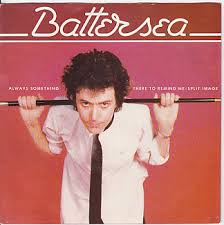 In the verses of the disc Charlie’s vocals are almost Iggy Pop-like, somewhat different to the more English accent he developed by the time of his solo work,(by then, ever-chameleon-like in his vocal abilities , he had adopted a post-Ziggy kind of punky style). With a lukewarm review in Melody Maker it soon disappeared. Today, fans of powerpop and New Wave collectors love it, especially the b-side!
In the verses of the disc Charlie’s vocals are almost Iggy Pop-like, somewhat different to the more English accent he developed by the time of his solo work,(by then, ever-chameleon-like in his vocal abilities , he had adopted a post-Ziggy kind of punky style). With a lukewarm review in Melody Maker it soon disappeared. Today, fans of powerpop and New Wave collectors love it, especially the b-side!
At some point in those days the band rehearsed in a big rehearsal rooms in Tooley St, near London Bridge. Interesting note is that the thunderous bass of Jah Wobble could be heard reverberating through the walls, as the new vehicle for John Lydon, PiL , was going through its early paces next door! Charlie absolutely loved this new incarnation for Johnny Rotten and the brilliant video that came out later that year. Strange thing also, at some stage later in the timeline, Adam and the Ants and Bow Wow Wow were rehearsing ‘next door’ in John Edward’s (Metal Mickey) studios on different occasions!

The band travelled down to Worthing for a seaside recording session at Pebble Beach Studios: two tracks were put down, “Save the Boy”, thought to be another potential single, and “When the shit hits the fan” (a pacy punk number), but no trace of them remains. Clapham life ticked over – pubs, gigs and parties……. Charlie’s girlfriend Pam got him and Andy tickets to see Bowie at Earl’s Court, June 30th. On that very morning his father passed away in Shropshire. His mother told him to carry on and go to the gig, as there was nothing he could do. Needless to say, though Bowie was terrific, thoughts were elsewhere. He headed home.
By the end of the summer he was back in London, but things with Pete Gage and the band were cooling. Mal Gray had taken a back seat, but seeing things in the doldrums he stepped in and upon Charlie’s return took him to do some backing vocals on a session he was doing for himself at The Workhouse, Manfred Mann’s studio in the Old Kent Road. Tony Gibbings was often there with Ian Dury and the Blockheads. Mal was recording with Tom McGuinness and Lou Stonebridge. The publisher of their work was a guy called Ray Williams who had managed Elton John at the start of his career, and also Steelers Wheel with Gerry Rafferty. Mal thought Charlie should meet Ray with a view to management, so he came down to the studios. Not long after that they came to an agreement and Pete Gage handed over the reins to Ray. It soon became clear that it was Charlie who was wanted rather than Battersea, but nevertheless the band tagged along to record new material at Ray’s offices based at Heath Levy Music in Regent Street. Some already written songs were re-worked, particularly Charlie’s “Somebody kissed me”. Ray took this song to Peter Meisel, head of Hansa Productions in Bruton Street. Meisel from Germany already had great success with Boney M, Ami Stewart and David Sylvian’s Japan, and had been on a talent search in the UK for a new act…Charlie was the result! So things seemed exciting. Unfortunately it was the end for Charlie’s association with Fish and Glenn Sissons, but Andy remained to do the recording session that followed.
Fraser Kennedy, upon Charlies’ insistence spoke to Dave Hill, the Pretenders manager, to get him a ticket to see Johnny Thunders’ Allstars at the Lyceum, on October 12th ’78. Both acts were on Real Records, with Thunders album ‘So Alone’ doing well.(It featured sax player John ‘Irish’ Earle, who also worked with the Clash, and would play the sax solo on Charlie’s “Hothead…”). The gig which featured guests playing with Johnny Thunders, such as Chris Spedding and Steve Jones and Paul Cook of the Pistols was filled with all the faces of the time…Bob Geldof, Paula Yates, all of the Pistols and the Damned….; there Charlie met Jan, who he would soon live with and marry, eventually having 2 children, Molly and Jack.
Mal got a phone call asking if he could find some musicians for a one-off gig in Paris. It was to back rock n’ roll legend Chuck Berry! He had added an extra date at the end of his autumn European tour and as the band had gone home he needed a ‘pick up’ band. Charlie and drummer Steve Murray flew out to Paris, and with no rehearsal went on stage with Berry, who did his own thing as ever, duck-walking to Charlie at the piano, encouraging him to go wild, ‘Jerry Lee style’. It was crazy but wonderful: Charlie didn’t know what ‘key’ any of the songs were in, so leant over the piano at the beginning of every number to work out the pitch! Chuck Berry seemed to love it; there he was on stage with a young English punk, spiky hair and leathers, belting out all those memorable songs, like “Johnny Be.Goode”. When they left the stage he soon disappeared, after the shortest of conversations, guitar case in hand. At the airport next day Charlie was lost in thought when a voice behind him said :”Hello, Guvnor!” He turned to see Ian Dury, with his friend Kosmo Vinyl! Apparently they had been at the gig the night before. Dury told him they couldn’t hear a note, but it looked great! He was in exalted company now anyway, with the likes of Keith Richards who had played with Berry, and also Bruce Springsteen, who described on TV a similar gig he had done with Berry at college.
Things moved swiftly with sessions back at Morgan Studios. Andy put some good lead guitar on another version of “Somebody kissed me”, but this proved to be his last bow with Charlie. He went back to Wales, though Charlie’s sights were on the charts and consequently rather self-centred. Recording continued on various songs, but “Blue Skies”, a song partly written about Sid Vicious in his prison cell in the States and partly about the machinations of the music business ( a recurrent theme for Charlie over the next year or so!), was chosen as the first single, backed with “Dreamworld”.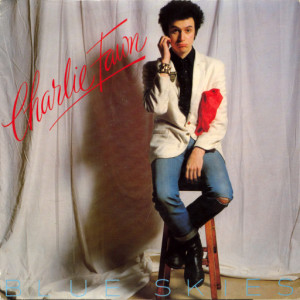
 Hansa records had now joined forces with WEA records to promote and distribute Charlie, so the famous Warner Bros logo was on his single. There was a photo shot of his signing, surrounded by Dave Dee and Peter Meisel, Ray Williams and his co-manager at WKLG, Fraser Kennedy.
Hansa records had now joined forces with WEA records to promote and distribute Charlie, so the famous Warner Bros logo was on his single. There was a photo shot of his signing, surrounded by Dave Dee and Peter Meisel, Ray Williams and his co-manager at WKLG, Fraser Kennedy.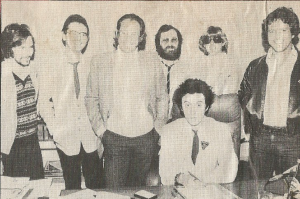 Photo sessions with Fin Costello and Martin Goddard were completed (in which Charlie wore more John Dove designs) and great excitement ensued at WEA who plastered photos of Charlie all over their foyer at Berwick Street..he was the flavour of the month and they were going to break him big! Bill Smith studio did the artwork for “Blue Skies”…only the best would do! Up in the press office at WEA, Moira Bellas and Dave ‘Monster’ Jarrett became good friends and fans of Charlie. He would chat there with them and others passing through, such as Chrissie Hynde and James Honeyman Scott of the Pretenders (who said he so loved “Blue skies”, he wanted to record with him,which sadly never happened as he died tragically young after early success with the Pretenders).
Photo sessions with Fin Costello and Martin Goddard were completed (in which Charlie wore more John Dove designs) and great excitement ensued at WEA who plastered photos of Charlie all over their foyer at Berwick Street..he was the flavour of the month and they were going to break him big! Bill Smith studio did the artwork for “Blue Skies”…only the best would do! Up in the press office at WEA, Moira Bellas and Dave ‘Monster’ Jarrett became good friends and fans of Charlie. He would chat there with them and others passing through, such as Chrissie Hynde and James Honeyman Scott of the Pretenders (who said he so loved “Blue skies”, he wanted to record with him,which sadly never happened as he died tragically young after early success with the Pretenders).
 A Mike Mansfield produced video for “Blue skies” was scheduled (“Cue Charlie!”), to be filmed at Ewarts & Co studios in Wandsworth. The evening before it Charlie was treated to far too much champagne from a fridge in Dave Dee’s office, thumping away at new song ideas such as “Hothead handshake tremble” on the piano, to the hilarity of Stuart Hornall of Atlantic Records. Apparently the champagne was destined for Renaissance’s gig that week…they never got it! But what Charlie did get was the mother of all hangovers upon heading off to the video shoot next day. He managed to pull it off somehow, surrounded by 50 life-size cardboard cut-outs of himself. Surreal. Rock n’ roll!
A Mike Mansfield produced video for “Blue skies” was scheduled (“Cue Charlie!”), to be filmed at Ewarts & Co studios in Wandsworth. The evening before it Charlie was treated to far too much champagne from a fridge in Dave Dee’s office, thumping away at new song ideas such as “Hothead handshake tremble” on the piano, to the hilarity of Stuart Hornall of Atlantic Records. Apparently the champagne was destined for Renaissance’s gig that week…they never got it! But what Charlie did get was the mother of all hangovers upon heading off to the video shoot next day. He managed to pull it off somehow, surrounded by 50 life-size cardboard cut-outs of himself. Surreal. Rock n’ roll!
At Mike Mansfield’s offices in Poland Street, Charlie had a crush on Betty Valentino (herself a Disco-music star a few years on). They had several fun meetings there, and on one occasion Betty said to Charlie ;”Meet George!” He turned to see a young, spiky-haired youth in an old raincoat and said:”Hi”…..people came to know this lad as Boy George!
They were heady days. Ray took Charlie to a high profile charity luncheon in Park Lane. He sat at a table with various artists including Blackfoot Sue (who he remembered from Top of the Pops), had DJ Mike Read from Radio One come over to say how much he liked “Blue Skies”, chatted with teenage heroes Robert Plant of Led Zeppelin and Noddy Holder of Slade, before Ray introduced him to Elton John! Surreal again.
It was February 1979. Sid died in America. Charlie drowned his sorrows at the Plough by Clapham Common Tube station.
A ‘Walkabout’ or tour of the nation was arranged to promote the single: visiting record shops round the country and signing the aforementioned cardboard cut-outs for the shop managers….Glasgow, Birmingham, Manchester. It was a sure-fire hit, said WEA.

The single charted at number 75 that week, but due to a clampdown by the compilers of The Charts, the well-used trick performed by record companies to break new acts by having them ‘hyped’ into the charts (having not really sold enough copies to warrant a chart-place) was scuppered on this occasion and the single was pulled out of the charts unceremoniously. It had worked time and again, no names mentioned, but it was Charlie’s bad luck to be the victim. The disappointment was palpable. Someone at WEA lost their job over it. So despite good reviews for the single from the likes of Rosalind Russell (of Record Mirror and the Evening Standard) in the music press it was doomed.
of Rosalind Russell (of Record Mirror and the Evening Standard) in the music press it was doomed.
Determined to redeem themselves WEA and Hansa pushed quickly for a follow-up single to be chosen from tracks being recorded for a debut album. It was “Hothead Handshake Tremble” which won, replete for UK release with Martin Goddard cover photo of Charlie standing in the Serpentine, Hyde Park… 


…..and it was schemed that it would be a track voted on in the new Saturday night primetime TV show, Juke Box Jury, presented by Mike Read. All looked set for success this time, with Charlie bumping into Jimmy Pursey of Sham in WEA’s office, who was a panellist on that week’s show, and who promised to vote the single a ‘Hit’! Only fate could stop it and did! The show never made it ‘On Air’ that Saturday due to a technicians strike at the BBC. Depression set in over the whole team, as if nothing could make it happen. Ironically, in the years since then, both these first singles have become highly valued by collectors and fans of the genre who have even told Charlie they bought them at the time, and can’t understand why he was never a big star.
During that period the eponymous first album “Charlie Fawn” was finished. Recorded at Marquee, Red Bus and Utopia studios, London, it was produced by Tom McGuiness and Lou Stonebridge, engineered initially by George Nicholson,(who Sid had famously glassed at the Speakeasy Club!) then remastered and further engineered by Richard Dodd – an early job in the career of the Grammy-award winning engineer of albums by Tom Petty and the Travelling Wilburys. It was an eclectic mix of punk, more melodic New wave and pop, with reggae and rockabilly, showing the artists versatility and potential. But what would happen to it on the back of the debacle with the singles?
Recorded at Marquee, Red Bus and Utopia studios, London, it was produced by Tom McGuiness and Lou Stonebridge, engineered initially by George Nicholson,(who Sid had famously glassed at the Speakeasy Club!) then remastered and further engineered by Richard Dodd – an early job in the career of the Grammy-award winning engineer of albums by Tom Petty and the Travelling Wilburys. It was an eclectic mix of punk, more melodic New wave and pop, with reggae and rockabilly, showing the artists versatility and potential. But what would happen to it on the back of the debacle with the singles?  It was released in various countries across the globe, which today’s vinyl collectors prove. “One in three” from the LP was released Stateside on ATCO to good reviews in the ‘New York Rocker’ and featured in Billboard.
It was released in various countries across the globe, which today’s vinyl collectors prove. “One in three” from the LP was released Stateside on ATCO to good reviews in the ‘New York Rocker’ and featured in Billboard.
 But……..
But……..
Fraser Kennedy managed a duo called Zoot Alors at the time, so Charlie guested on piano with them on the kids TV show ‘Get it together’ at Granada studios in Manchester, where he held a door open for Dame Edna Everage to pass(!). It was bizarre, as show presenter Roy North (of Basil Brush fame) excitedly told Charlie how much he liked his single “Hothead”, and had been playing it on his radio show and at nights at Wigan Casino, home of Northern Soul! Even more strange, also appearing were Secret Affair, whose singer Ian Page used to chat to Charlie before he’d even formed his first band the New Hearts, as if Charlie was the veteran after his Domino tours! Funnily, during the recording of the show producer Muriel Young told him to stop chewing gum, as it was a bad example to kids, so he took it out of his mouth and stuck it under the hired piano!
Also in the stable of artists at WKLG (Heath Levy) managed by Fraser were Eric Bell (ex-Thin Lizzy), Kris Ryder and Andy Desmond (who co-produced Charlie’s later version of “Always Something” and went on to great things as Miten with Deva Premal, in the genre of meditation and New Age music). Christian band ‘After the Fire’ were on the rosta, whose bass-player Nick Battle acted in something of a managerial capacity for Walk the Circle in the late 1980’s!
Charlie appeared on Top of the Pops early in 1979, playing keyboards for Tom and Lou as their single “Oo ee baby” entered the lower regions of the charts. He had helped with backing vocals on their new album, produced by Mike Moran at Air Studios. Moran was also on the TV show with them, introduced by Mike Read. (During the sessions for Tom and Lou’s album at Air Studios, Ray introduced Charlie to legendary Beatles producer George Martin who was working in the next door studio with Pete Townshend of the Who. As a music fan, it doesn’t get much better!) At Top of the Pops Charlie had fun catching up with Kenny Morris of the Banshees who were on the programme, as were the Police and even more interesting a very amusing John Lydon and Public Image Limited, who enjoyed seriously winding up the TV crew.
He had helped with backing vocals on their new album, produced by Mike Moran at Air Studios. Moran was also on the TV show with them, introduced by Mike Read. (During the sessions for Tom and Lou’s album at Air Studios, Ray introduced Charlie to legendary Beatles producer George Martin who was working in the next door studio with Pete Townshend of the Who. As a music fan, it doesn’t get much better!) At Top of the Pops Charlie had fun catching up with Kenny Morris of the Banshees who were on the programme, as were the Police and even more interesting a very amusing John Lydon and Public Image Limited, who enjoyed seriously winding up the TV crew.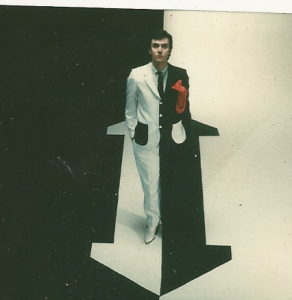
For Charlie a new approach was needed and taken soon. A band was again put together to back him. A guitarist he auditioned from Birmingham, Steve Bennett really fitted the bill ( he’d played on Opportunity Knocks TV show with the Cissy Stone Band) and joined Paul Karas on bass (Apache hair) and Roy Morgan ( session drummer who played on Art Garfunkel’s “Bright Eyes”) also of Stackridge, along with their keyboard player Rod Bowkett. Apart from working on a number of demos they did several gigs round the London area, such as the Marquee (supporting the Blues Band, Tom McGuinness’ band, which Ray was looking after) the Rock Garden and Wimbledon Nelson’s. The band wasn’t a fixed entity yet though, and auditions for permanent members continued, some held at EZee Hire in Caledonian Road, where despite hearing loads of drummers it was in fact Andy Ebsworth, who was setting up the ‘gear’, who shyly played and then got the gig! He came to watch the band as it was at Nelson’s before stepping up.
The decision was to continue gigging to build up a following. Andy (drums)and Steve (guitar) were soon joined by Steve Gurl on keyboards. He had played with Babe Ruth, and was also the writing partner of Gary Fletcher, bassist in the Blues Band. Years before he had worked with Pete Gage! Even more strangely his local pub ‘The Nightingale’ was the watering hole for Dave ‘Monster’ Jarrett from WEA’s Press office, who got on so well with Charlie! The line-up was completed by bass player Chris Dempsey (Dirkin) and showed great promise, arranging and bringing Charlie’s latest songs to life. The feel of a ‘band’ gave an urgency and energy to the tracks recorded, which can clearly be heard, by comparison to the much more studio-based recordings which preceded them. With a number of gigs, such as Aston University, Birmingham, and many of the small London venues such as the Marquee, the Rock Garden, Dingwalls, the Half Moon Putney, Zeetas, the Nashville
With a number of gigs, such as Aston University, Birmingham, and many of the small London venues such as the Marquee, the Rock Garden, Dingwalls, the Half Moon Putney, Zeetas, the Nashville and a great gig at the ‘Music Machine’ Camden (captured on camera by Charlie’s best friend Larry Hinrichs)
and a great gig at the ‘Music Machine’ Camden (captured on camera by Charlie’s best friend Larry Hinrichs)









 Some of the same kids were seen at consequent gigs and calling out for one track in particular…”Mister Unknown”. Even Moira Bellas left her office to see Charlie perform at ‘The Kensington’. Things seemed on the up.
Some of the same kids were seen at consequent gigs and calling out for one track in particular…”Mister Unknown”. Even Moira Bellas left her office to see Charlie perform at ‘The Kensington’. Things seemed on the up.
He continued to meet people who he had appreciated in the world of music: he enjoyed drinks on more than occasion down an out-of-hours pub , the ‘Tatty Bogle’ near Carnaby Street with Billy Bremner, the guitarist of Dave Edmund’s ‘Rockpile’, who he had watched on Top of the Pops in 1970 performing “I hear you knocking”(written by Fats Domino!). He met both Bruce Welch and Hank Marvin of the Shadows, and Les Mckeown of the Bay City Rollers, with songwriter Scobie Ryder. A good deal of Ray Williams time by then was spent on promoting a compilation release of the works of Manfred Mann, and all the original members met in Carnaby Street for a reunion lunch. Charlie attended and found himself looking at the faces he he had first seen as a boy in Shropshire, many dreams earlier! The album did well.

But by now he was showing signs of a growing frustration. This is reflected in songs he wrote during this period, such as “Walkabout”…(‘busting to chart but got found out!)… and “Uptight”…( Who-d ya get in touch with?…). At a Blues Band gig at The Venue, Victoria, he firstly drunkenly chatted with Pete Townsend of the Who, praising him for his trademark ‘windmill’ armed appearance with the Clash in Brighton that week, before a misunderstanding with Jan resulted in him sweeping a Till and umpteen glasses and bottles off the bar and smashing them to the floor, before being hoisted out of the club by the bouncers. He had to write a letter of apology to the club management to avoid costs, which was only smoothed over since he had the same management as the Blues Band. Rock n’ roll!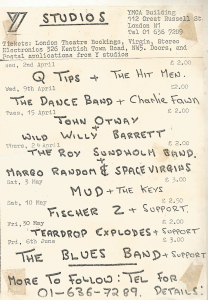
Charlie made an image change at this time, which says something of his being more unsettled: he had a skinhead crop done, moving away from the flamboyant punk ‘look’ of the previous few years. This was less about the advent of new and successful bands Madness, the Specials, UB40 and the Selecter ( all of whom he liked a lot) and more about annoying the record company. 
In 1980 a new version of old staple “Always something” was co-produced by Charlie and Andy Desmond as a third WEA single.  Third time lucky? This was a ska-influenced and souped- up version, which the band was chosen to promote as a live session on the Andy Peebles Radio One afternoon show. It would be repeated every day for a fortnight. And soon people were going into the record stores asking for it, only to discover it was unavailable due to a distribution mix-up! Unbelievable. Charlie had had enough. He badmouthed WEA on-stage at a virtually empty gig in Shrimpers Club, Southend. Suffering with flu and high temperature, fuelled by port and brandy, he was heard by a DJ who happened to know Moira Bellas. He had to apologise to her, but she knew it was frustration at the way things had panned out.
Third time lucky? This was a ska-influenced and souped- up version, which the band was chosen to promote as a live session on the Andy Peebles Radio One afternoon show. It would be repeated every day for a fortnight. And soon people were going into the record stores asking for it, only to discover it was unavailable due to a distribution mix-up! Unbelievable. Charlie had had enough. He badmouthed WEA on-stage at a virtually empty gig in Shrimpers Club, Southend. Suffering with flu and high temperature, fuelled by port and brandy, he was heard by a DJ who happened to know Moira Bellas. He had to apologise to her, but she knew it was frustration at the way things had panned out.  He didn’t hang around for any more post-mortems and announced to the band at Steve Gurl’s house in Nightingale Lane that he was quitting. The reaction was understandably mixed, between tears and disgruntlement. But he had made his mind up. He and Jan disappeared from their flat in Bow. No-one knew their whereabouts. And quite strongly, the conflict between the desire for fame and fortune, pitted against the quest for spiritual truth raised it’s head again: circumstances somehow brought back the loss of his father a couple of years earlier and made all he had been doing seem pointless. He wanted to break all his contracts. (As it happened Peter Meisel of Hansa had begun to lose interest in Charlie, possibly because he didn’t understand his artistic stance and direction anyway; shortly after this he decided not to go any further with Charlie’s contract). Job done. End of another era.
He didn’t hang around for any more post-mortems and announced to the band at Steve Gurl’s house in Nightingale Lane that he was quitting. The reaction was understandably mixed, between tears and disgruntlement. But he had made his mind up. He and Jan disappeared from their flat in Bow. No-one knew their whereabouts. And quite strongly, the conflict between the desire for fame and fortune, pitted against the quest for spiritual truth raised it’s head again: circumstances somehow brought back the loss of his father a couple of years earlier and made all he had been doing seem pointless. He wanted to break all his contracts. (As it happened Peter Meisel of Hansa had begun to lose interest in Charlie, possibly because he didn’t understand his artistic stance and direction anyway; shortly after this he decided not to go any further with Charlie’s contract). Job done. End of another era.
The rest of the band carried on for a while using the name ‘Graffiti’, after Charlie’s song “Graffiti in the Underpass.” But then Andy and Steve moved on to play in Clive Gregson’s ‘Any Trouble’.
Charlie and Jan had in fact hidden away at her parents home in Sidcup, before hunting for a place to live the ‘Good Life’, back to the land, on the south Kent coast near Hythe: and there to delve more deeply into Zen, tai chi, meditation and yoga ( they visited the Hare Krishna temple in London often and stayed at Chaitanya College with friends Janananda Das and Jagatam Devi Dasi). It would be a while before he resurfaced. They were married in February 1981. He got in touch with Andy Ebsworth, who came down to stay with his American girlfriend and a huge carrot cake. It was a good friendship. Sometime after that contact was made again with Ray Williams, who met with Charlie in London. By now Steve Gurl was working for him, and a session was arranged for some recordings of new songs. Things were very different now though and the material was much more pop mainstream. Gary Fletcher helped out on bass, lead and production, Andy on drums, Charlie on piano. Nothing ever came of it. It was around about this time that Charlie also received a couple of strange but potentially interesting enquires: firstly an invitation to join Shakin’ Stevens band as piano player, and then a call from one of the singers in The Flying Pickets, as to whether he might like to join them! His ego and his musical sensibilities resulted in a firm ‘no thanks’ to both. He now turned his creative talents more to poetry and his spiritual interests, Zen and meditation. He became vegetarian.
By 1985 Charlie had been back in London for a year working at a vegetarian restaurant. He heard from Jerry Tilley, who had by now appeared on the Royal Variety Show on TV playing lead guitar for Bill Haley, with Mal as MC and rhythm and Steve Murray on drums. Jerry and Charlie had previously met up again whilst Jerry had briefly played with the legendary and under-rated genius known as ‘Shrink’ (David Banks). Jerry now had his own Thameside Studios in Rotherhithe where he even engineered sessions for Lee Scratch Perry(!) and offered Charlie some studio time, to work together. It fired him up again and they put down several tracks, including the poppy “Just for you”, a big ballad called “Spark” and “Heavily into you” and “Walk the Circle”.
Jerry now had his own Thameside Studios in Rotherhithe where he even engineered sessions for Lee Scratch Perry(!) and offered Charlie some studio time, to work together. It fired him up again and they put down several tracks, including the poppy “Just for you”, a big ballad called “Spark” and “Heavily into you” and “Walk the Circle”.  They experimented with synthesiser and drum sounds, Charlie slipping between that punky voice and something more ’round’. Once happy with them he got in touch with Moira Bellas, who was always pleased to hear from him, and she set up a meeting for him with WEA’s A&R man of the time Bill Drummond, who had worked with Echo and the Bunnymen,(and who himself gained some notoriety with The KLF). Unfortunately, though he was interested, Bill didn’t go for it, so Charlie met up with Ray Williams in Covent Garden. Ray seemed to quite like the material, but it felt like a blind alley. It would be 20 years before they met again.
They experimented with synthesiser and drum sounds, Charlie slipping between that punky voice and something more ’round’. Once happy with them he got in touch with Moira Bellas, who was always pleased to hear from him, and she set up a meeting for him with WEA’s A&R man of the time Bill Drummond, who had worked with Echo and the Bunnymen,(and who himself gained some notoriety with The KLF). Unfortunately, though he was interested, Bill didn’t go for it, so Charlie met up with Ray Williams in Covent Garden. Ray seemed to quite like the material, but it felt like a blind alley. It would be 20 years before they met again.
In 1986, on the back of these sessions though, armed with the tracks, Charlie answered an advert in Melody Maker which intrigued him. Normally his ego would have got in the way, but somebody wanted to find a vocalist for a band influenced by the Psychedelic Furs, the Waterboys and the Pretenders…all faves of his. Having made contact he set off to the bass player’s flat in Camden. It was Karl Watson, who had been in the Dogs d’Amour…all Ronnie and Keef-style rock n’ roll: he worked as a DJ in the St.Moritz club in Wardour Street, knowing the likes of Lemmy from Motorhead, who he introduced Charlie to. With him there was guitarist Neil Cole from Leicester. Almost immediately after hearing Charlie’s tapes, and already getting on like a house on fire, they asked Charlie to join. Great fun was spent in the ensuing weeks trying out ideas as Neil and Charlie co-wrote material in the unique atmosphere of Camden Town. The desire was to create something new and different. Karl wanted to get away from his rock n’ roll lads image, all trash and New York Dolls style, to something more artistic. Neil also was determined to create a different sound, without entering the territory of U2’s the Edge or Simple Minds, both becoming huge at the time. He had developed a quite unique ‘chorus’, almost orchestral multi-layered guitar sound, which really captured Charlie’s imagination. It sent his creative juices flowing into poetic and almost mystical landscapes, unlike anything he’d envisioned before: echoes of Jim Morrison and Mike Scott (‘Whole of the Moon). He again changed vocal style, with more depth and warmth. Initial songs were crafted over this orchestral sound, with enigmatic lyrics. Beneath it all Karl pumped a solid bass, with occasional elaborate touches. It worked! They were enthused, and decided it was time to find a like-minded drummer. Advertising again the most likely candidate was a Scot, Alan Stuart, who had done sessions for various artists including Five Star. He seemed to get the gist of what the guys were hoping to come up with quite quickly, feeling he too didn’t just want to hammer out rock drums, but to be inventive and almost classical. The band soon formed a strong working and friendly relationship and thought about a name. After not too much debate the others went with Walk the Circle, after Charlie’s song-title. It conjured up the image of walking the circle in Tai Chi and even referred to Wicca. He didn’t disagree.
Walk the Circle met for rehearsals in Camden, at Charlie’s house in Sidcup or Alan’s flat in Fulham. A fascinating collection of songs gradually grew, with the band dressed mostly in black, but with waistcoats and Byronic style. Charlie now sported long hair. There was a real sense of building something unique and singular. Many times during song-writing sessions Neil and Charlie surprised themselves with moments of shared illumination. It felt great.
The band worked on a body of material for a live set and looked round for management contacts and potential record deals. Close friends and acquaintances began to feel quite a buzz round them and looked forward to gigs and new demos. They had publicity shots done, and through contacts they found studio time Upstairs at The Workhouse. The sweeping orchestral live-sound created by Neil was difficult to capture on tape, but some good tracks went down, “Rapture”, “Below the surface” and the anthemic “Triumphant”.
Coincidences continued to abound in Charlie’s life. He went to visit Andy Ebsworth and Steve Gurl in Nightingale Lane, Clapham, to muse over old times, when Andy and he sat in the basement studio and played through “Mister Unknown” together; Andy still loved it. But things got more bizarre when having a drink after in ‘The Nightingale’. It turned out that 2 musicians were using the basement studio to do some demos. The guitarist joined Andy and Charlie in the pub. He said he lived in Fulham and his mate was now drumming in a great new band. Charlie doubted but had to ask…”What’s his name?” “Alan”…and the band? “Walk the Circle.” Charlie couldn’t believe it, nor could the guitarist Keith More, when told that it was his band! Keith added how much he liked the band’s sound and particularly the track “Below the surface”. So two of Charlie’s musical-career world’s collided!
And even more bizarre…at The Marquee, Karl introduced Charlie to Rene Berg, who amongst other things had played bass in Hanoi Rocks, but turned out to have been at school with Charlie in Cambridge ( as one Ian Bruce, who Charlie recalled wearing then outrageous winkle-picker Chelsea boots!). They indeed remembered each other as schoolboys.
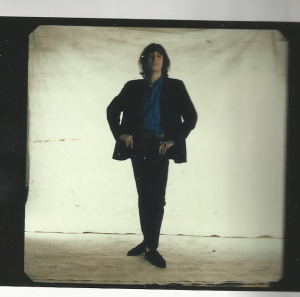

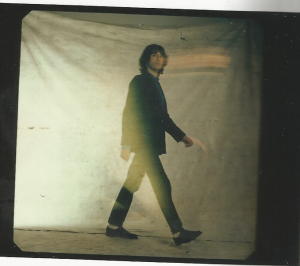

Keith More became a great fan of the band, coming to all their gigs and was a close member of the ‘family’ entourage; he himself went on to be recognised as one of the great guitarists of his generation. It was clear to onlookers that he and Charlie were bad influences on each other when out clubbing!
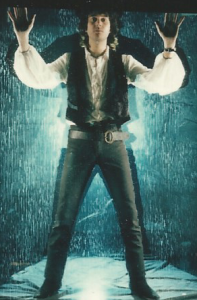 Gigs all round the London circuit began. Karl’s contacts at the Marquee meant a number of slots as support for various bands, including Ten Ten from the States. They socialised with Then Jerico, whose drummer Steve Wren lived near Charlie.
Gigs all round the London circuit began. Karl’s contacts at the Marquee meant a number of slots as support for various bands, including Ten Ten from the States. They socialised with Then Jerico, whose drummer Steve Wren lived near Charlie.

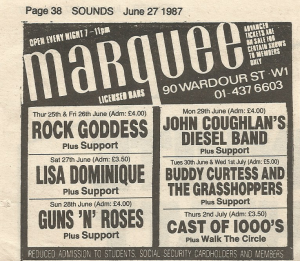
Despite excessively celebrating Charlie’s birthday in December the night before, their debut at the club and fuelled by ‘hair of the dog’ got a good reaction. There was one memorable night headlining at the Rock Garden, where they went down a storm, people even waltzing to the song “Move to tears”! This gig was booked through Nick Battle (coincidence-time again, the ‘After the Fire bassist’, who was by then working for Miles Copeland(!) at IRS). They rehearsed several times at The Clink near London Bridge, and Charlie met Robert Plant again, rehearsing his new band in the studio next door. 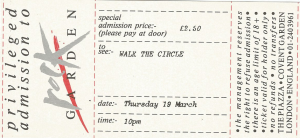






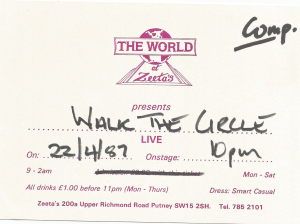

In the late spring of 1987 they were booked to support Deacon Blue at ‘The Mean Fiddler’.  It was a good night and some of it recorded live for posterity. The sad truth is that it turned out be their last gig. Within days Charlie’s mother was taken seriously ill and he returned to the Midlands. He was there for most of the summer as she faded in hospital. After her passing he felt very differently again about life. Once more he felt drawn to the spiritual side of his nature rather than the seemingly ego-driven desire to ‘make it’ in the music business. When he and Jan returned to London, (Charlie with an Oscar Wilde look about his hair and dress) things with the band were struggling somewhat, at the very least financially. Some business interest was found though and they secured more studio sessions which resulted in the striking song “Firewalking” and the equally unique “In the Meantime”, which managed to capture some of their sound. But despite these new tracks and every effort, there was no breakthrough forthcoming. The band simply couldn’t carry on much further without business backing and Charlie’s heart was no longer in it. Karl and Alan felt some sort of ‘swansong’ was required, a last gig maybe, however sad. But when it was mooted and even certain dates put forward Charlie declined. Karl was hurt, while Neil simply kept his peace. It was over.
It was a good night and some of it recorded live for posterity. The sad truth is that it turned out be their last gig. Within days Charlie’s mother was taken seriously ill and he returned to the Midlands. He was there for most of the summer as she faded in hospital. After her passing he felt very differently again about life. Once more he felt drawn to the spiritual side of his nature rather than the seemingly ego-driven desire to ‘make it’ in the music business. When he and Jan returned to London, (Charlie with an Oscar Wilde look about his hair and dress) things with the band were struggling somewhat, at the very least financially. Some business interest was found though and they secured more studio sessions which resulted in the striking song “Firewalking” and the equally unique “In the Meantime”, which managed to capture some of their sound. But despite these new tracks and every effort, there was no breakthrough forthcoming. The band simply couldn’t carry on much further without business backing and Charlie’s heart was no longer in it. Karl and Alan felt some sort of ‘swansong’ was required, a last gig maybe, however sad. But when it was mooted and even certain dates put forward Charlie declined. Karl was hurt, while Neil simply kept his peace. It was over.
Charlie laid low for a good while before in 1990 he heard from Mal Gray once more, wondering what he was up to. Mal could still not believe someone of Charlie’s talent wasn’t ‘out there’. So he arranged some studio time in Purley, South London. Charlie did have some material he felt quite happy to ‘put down’, albeit very simply: just voice and piano. He astonished the engineer by laying down all the tracks in one take, backing vocals and all. The session saw him present himself very differently, with some homage to the sound of Scott Walker, even the Righteous Brothers. The songs “River of Love”, “Hands across my heart” and “Out there somewhere” show his chameleon-like vocal abilities, when compared with earlier work, and have a rare quality in the simple voice and piano mix.
Mal thought it had gone really well, but didn’t himself choose to do anything with the tapes. Instead, Charlie found himself meeting up again with Fraser Kennedy, who was now working out of Robert Stigwood’s offices, handling the likes of Eric Clapton. He was impressed with the tapes, but failed to act on it. He remarked however, about how badly he felt for Charlie what had happened during the years at WKLG, and that he had been a ‘victim of the industry’.
Charlie’s next move was to contact James Wyllie (who he had met with Walk the Circle). Wyllie was a lawyer who managed Annie Lennox and the Eurythmics. He was very pleased to hear from Charlie, and really liked the songs and the sound. Honestly though, he was unsure how to approach marketing it, and was very busy with the Eurythmics new greatest hits album, so he felt it unfair to promise anything might develop. At a get-together with the other members of Walk the Circle there was a good deal of surprise and approval of these new recordings, but no chance of a reunion.
Finally, Charlie met again with the ever-supportive Moira Bellas, now at East West Records in Kensington. She was pleased to see him and blown away by the Walker-esque style of the tracks. They caught up on the punk days and she promised she would put the tapes on the desk of ‘the guy who signed Madonna to Warners’. Charlie thanked her.
But….that was that.
In 1992 Mal invited Charlie to join his ‘American Pie Rock n’Roll Theatre’ on tours of the UK and the Middle East. So in a sense, things had come full circle, since that meeting on a train at Canterbury West station nearly 20 years before. Recordings were made from the show, produced by Mike Vernon ( Albatross-Fleetwood Mac), and Charlie did his party trick of putting down the lead vocals for “Sherry” in one ‘take’ – bass voice then leaping up to falsetto in one line(!); other vocals he did were “Only the Lonely”, “Dream Lover” and a great version of “Sixteen Candles”. A promo video was made of the latter and other numbers from the show, which is viewable on the Charlie Fawn Facebook page, and film of Charlie playing the piano instrumental “Nutrocker” live on stage is on the Web, along with Mal’s rendition of Gene Vincent’s “Baby Blue”. (A light went out when Mal Gray passed away on March 20th 2017; without his discovery of, and belief in Charlie there might arguably have never been a ‘Charlie Fawn’. A mentor, inspiration, manager and most of all friend to Charlie, whose humour, enthusiasm and advice will be sorely missed. Fans of the Wild Angels will remember him as a great frontman, and with hu ge affection. (Photo left- Charlie performing “Dream Lover” live, Mal Gray to his right.)
ge affection. (Photo left- Charlie performing “Dream Lover” live, Mal Gray to his right.)
 ( Charlie, left …Mal with his back to camera…Steve Murray, right- drummer also for Bill Haley…left front- Carole Forbes, aka Gloria Sunshine from Rocky Sharpe and the Replays, also sang with Chris Farlowe…and right front, Julia Galliers.)
( Charlie, left …Mal with his back to camera…Steve Murray, right- drummer also for Bill Haley…left front- Carole Forbes, aka Gloria Sunshine from Rocky Sharpe and the Replays, also sang with Chris Farlowe…and right front, Julia Galliers.)
After the Millenium Charlie began writing again after a very long break. He had a ‘long-time no-see’ lunch with Dave Stark in Hampstead, who offered to help him record new ideas. With a nod to Gram Parsons and Country Rock, he recorded a number of country-style songs, with an American ‘twang’ to his vocals. There were echoes of Hank Williams and even a premonition of the likes of the Kings of Leon in the breadth of these home-produced recordings, which he saw as a Country Punk hybrid. Charlie played all the instruments so as to achieve that raw punky-feel to the guitars and did all the vocals.
Charlie played all the instruments so as to achieve that raw punky-feel to the guitars and did all the vocals.
In 2005 he once again met with Ray Williams, who with a positive reaction and after much reminiscing, took copies of his new work off to the States.
Nothing came of it.
The variety of musical genres which he had travelled through over the years shows the wide scope of Charlie’s talents. To Charlie the Art of song-writing, of expressing emotions and feelings through that chosen media was similar to painting: each song a new work of art, unique in its own right, however polished or rough, however elaborate or simple. They stand as works of art as they are.
And…..after all is said and done, the ‘listener’, the music fan is the best judge.
With the impetuosity of youth and perhaps mistaking stardom for artistic appreciation, at 21 he had written “A Somebody”, which contained these lines:
” Made up my mind in my own good time I’d be up there too in the Rock Who’s Who….rubbing shoulders with the Elvises, receiving gold discs and Miss World’s kiss! Really wanna be a somebody, not just any nobody…”
Maybe he had tempted fate too openly with this drive to succeed!
With hindsight it would be fair to say that though looking for elusive commercial success Charlie was always equally bent on his quest to create, to write the Perfect Pop Song: a Grail which he glimpsed in work such as ‘One in Three’, ‘Paper Trails’ and ‘Step by Step’. As the years progressed this was no less evident, whatever influences came to bear on his writing, be they reggae, blues or country. So the obvious homage to the likes of Hank Williams (in ‘Blue blue Shades’) or to Gram Parsons throughout his exploration of country and country rock: with the desire to also create something of value in that style or genre.
As one with a natural creativity Charlie continued to write and record whenever the muse took him, but more with the desire to express himself artistically than to achieve any recognition. In recent years he has devoted his time to his family, become a grandfather, and continued to explore the more spiritual, contemplative side of his nature. It was not that now Charlie had suddenly ‘got religion’ as they say, – rather that the spiritual ‘vein’ which had run throughout his life seemed more easy to ‘mine’, to relax into and share. Some blues and even spiritual songs have flowed, but more personal and reflective. He was inspired to write and record a number of devotional pieces, inhabiting some of the same space as great influence George Harrison. He has been proud to work during these later years with his son Jack Coxill, a phenomenal guitarist and great vocalist- a chip off the old block indeed!- who was in Dartford band Passion for Cats, before leading the band GYNX, whose psychedelic funk album “Mind the Groove” showcases Jack’s skills and talent. One track in particular which Jack recorded with Charlie in 2008 is the epic “Revelation Days” ( which you can hear on the ‘Charlie Fawn’ Music page). This came about after the death of Jack’s good friend Rob Knox, who had recently been in a Harry Potter film, but was tragically murdered in May that year. Jack was only 17 at the time, but his extraordinary guitar playing belies his years.
Exploring Tibetan Buddhism, the Hare Krishnas ( since those heady mid-70’s days in Canterbury with school friend Arjuna Ardagh, the ‘Awakening’ coach and pupil of the Indian guru ‘Papaji’) the inter-spiritual dialogue of Fr Bede Griffiths and Swami Abhishiktananda, where Non-duality meets Christianity, and the world of Saint Francis of Assisi, Charlie sought to make sense of all these glimpses of something greater, which music itself attempts to communicate….so he was re-discovering the glorious sounds of his childhood days in Cambridge and wondering whether he could integrate it with the rock music he had adopted so long ago as his ‘medium’, but which careered him off the rails and dragged him along like a runaway horse from which he’d fallen whilst having one foot still caught in the stirrups!
(On the street in the Strand, London, with homeless dog Max, 2008)

A life journey of so many parts, which can best be appraised as they must inevitably and eventually come together – the brush strokes of one amazing self-portrait, all equally valid and important in adding colour to the ‘un-finished’ article. Some may be surprised by the diversity of styles, genres and lyrical content this Artist has revealed. But the whole picture has to be visible to be appreciated.
It is therefore intended that in time more material will be added to this site which may indeed surprise some ‘fans’. But the challenge for them is to then appreciate one Artist’s travels and life experiences, who feels moved to share and express them with others via this musical medium.
So, finally…how does one define fame and fortune? The artistic persona ‘Charlie Fawn’ and other ‘aliases’ are at present scattered across the world-wide web on vinyl, digital downloads and fan ‘forums’ and ‘blogs’.
“Living in a dreamworld I can’t really win….but living in oblivion I ain’t worried ’bout a thing!” (Charlie Fawn, ‘Dreamworld’ 1979).

To be continued….?
In memory of Larry Hinrichs…… friend, Nips guitarist and Damned-fan extraordinaire…..sleeping on each other’s floors after gigs in the hey-day of punk, fry-ups at the Golden Egg Clapham Common, Martini at The Speakeasy, and taking in the ozone on Hythe sea-front etc. Love x
R.I.P Mal Gray. Thanks for everything x
Happy significant birthday Charlie!
Amazing to hear from you Roddy….happy days in the swinging sixties, now we’re in the swinging 6o’s!! Best wishes x